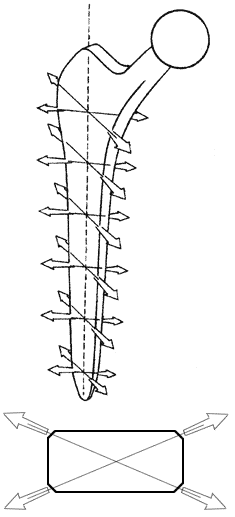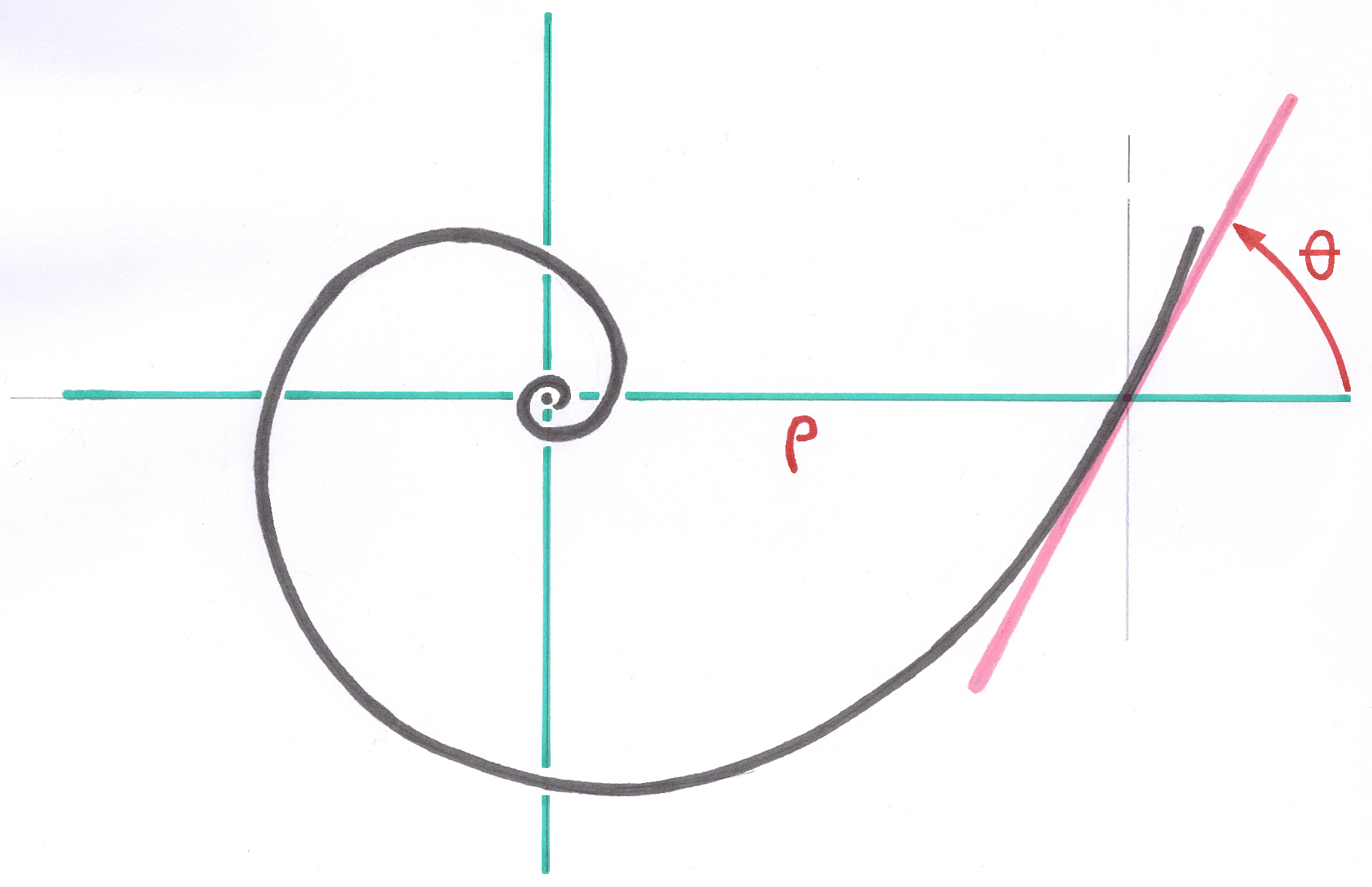2.5. The Principle of Distributed Constraints
2.5.1 Summary
With a Geometrical Anchoring, so that the bone is everywhere in the Domain of Bone Vitality, more possible large surface of the implant must take part in the anchoring constraints, and not only some zones.
The fact of allotting a particular function to a zone removes part of usable surface for the participation in the work of anchoring.
So that no point of the bone is in hyperpression or excess of constraint, which would cause the resorption of the bone and the intense pains, all the fixation zone, which must be more the possible extent, must remain in the Field of Bone Vitality.
This is the Principle of the Distributed Constraints.
2.5.2. Quasi uniform Distribution
With a stem fixed by Geometrical Anchoring, the constraints are transmitted towards the bone while seeming to come from the vertical axis of the diaphysis, which corresponds to a radial distribution, quasi uniform, i.e. the totality of osseous surface in contact with the implant takes part in its immobilization, even in the extreme situations of dynamic stress.
Since each point takes part, none is overloaded to the extreme.
2.5.3. Prestressing is indispensable.
A Prestressing of the osseous bed at the end of the implantation is a big factor to decrease the risk of Micromovements of the stem in its osseous bed. The stems with Geometrical Anchoring are the only cementless stems whose geometry puts the bone in moderate and regular prestress, therefore with the shelter of the micromovements as of the first day of implantation, without awaiting for a possible bone regrowth.
2.5.4. Respect of the Field of Bone Vitality
To satisfy Geometrical Anchoring, and to take into account the Field of Bone Vitality, it is necessary on the one hand that more possible large surface of the implant takes part in the constraints of anchoring and not only some privileged and specialized zones, and on the other hand to prevent that an area or that a point of the implant is not in situation of hyperpression or excess of constraint and thus in situation of local resorption. All the osseous fixation zone of the implant must remain in the Field of bone vitality.
That is the Principle of Distributed Constraints.
2.5.5. All the zones must participate
If an implant is in contact with a too restricted fraction of the whole of the osseous bed which is intended to him, the totality of the constraints coming from the statics and the dynamics of the patient is applied to a too small surface. So in certain contact points with the implant, the bone receives too high pressures, the bone resorbs at the contact points, the prosthesis can be inserted and, often, the patient perceives sharp pains at the time when a concentrated loading becomes excessive.
To obtain the Distributed Constraints, one of the means of which I lay out is to increase the primary surface of contact (postoperative) by a judicious drawing of the implant. For that, I am not of opinion to be given, at various zones of the prosthesis, independent specialized functions.
The typical counterexample would be a prosthesis of which the metaphysary part, made bulky, would only receive as function to support the weight of the patient, and of which the diaphysary part would be cylindrical, polished, and would have as only function the axial stabilization of the implant, but would not have any function of resistance to the axial penetration.
So to that, one adds a flange who, if it arrives in contact with the cut of the bone neck, prevents even a primary contact of the zone of anchoring, the prosthesis will never reach an acceptable and painless primary stability.
In my opinion, a stem without cement must take support on the totality prepared osseous length. All the zones must have a function of resistance to the penetration. It is illusory to hope for absolutely equal constraints in all points. If all the zones take part, none will be overloaded.
2.5.6. Application of the Law of Positive Derivates
To obtain this property of the Distributed Constraints, not only the transverse sectional surface of the stem must increase, without interruption from one end to another, but moreover the radial distance to the axis of any point of the section must also increase.
In addition, the expression of mathematical type of this condition is that the first derivate of the distance to the axis in all respects, and the section, must be positive and continuous, and that the second derivative must be at least continuous.
One more very important condition is the Prestressing of the bone so as much as possible radial. This requires the preparation of the bone bed in a form very similar to that of the prosthesis. It is not necessary that the prosthesis is absolutely everywhere in contact with cortical bone. It is what I express under the expression Partial Rectification
Thanks to the application of the preceding mathematical rules, an impaction of the stem at the end of the implantation provides the setting in prestress. a radial prestress is obtained in the bone by the application of suitable conditions to the form of the cross section of the stem.
In the absence of any request, the stem would be motionless in its osseous bed, but as of the application of constraints due to loading, certain points of the stem would leave the contact with the osseous sleeve because of absence of Prestress which would dynamically force the maintenance of the contact in the bone. Micromovements would appear compared to the osseous bed and the Osteointegration would not take place for secondary stability.
2.5.7. Particular calculation of the rasps
To optimize the distribution of the constraints, by small differences introduced by calculation, between the associated stems and rasps, it was possible to me to seek a quasi-suppression of the pains, previously considered as normals for prostheses without cement.
To obtain the Distributed Constraints, it is also necessary to prepare the osseous bed with rasps adapted to the implant if possible programmed by calculation at the same time as the description of the stems. The precision of realization of the rasps must be close to 20 microns. The rasps should not be strictly identical in length to the stem because additional impaction at the end of the implantation would have no effect.
With sufficient computing resources, it is possible to introduce between the rasp and the stem small differences in size or slopes to act voluntarily in a set to the distribution of the preload of the bone along the stem.
This application, for example, stems SLR-Plus for reoperations of the average depth where you want to load more the intact profound cortical bone when the proximal bone is degraded.

----
